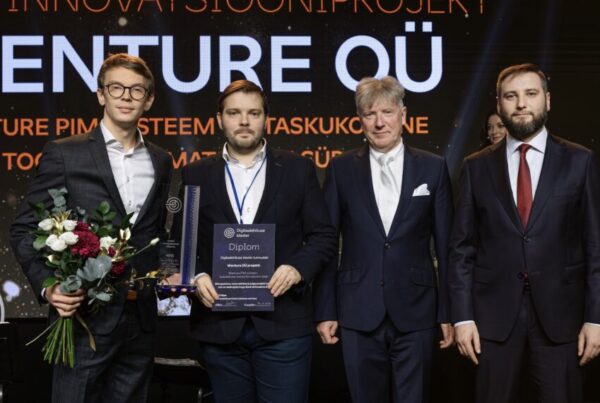The employees in the construction sector have long been using mobile apps to order food, using self-checkout in stores, and signing documents with their mobile phones. One might think that the market is long ready for digitalization, but upon arriving at the construction site, wrinkled papers and manual laborers are still prevalent. What are the underlying reasons for the slow digitalization of the construction sector?
These questions have been discussed in the 2022 McKinsey study, which takes a research-based look at the root causes of the problem. We see that achieving efficient growth in the construction sector is particularly challenging for four main reasons: fragmentation in the construction sector, project-based approach, low margins, and difficulties in adapting to change.
Wenture CEO Kaur Tull takes a closer look at the obstacles outlined in the study and shares advice for construction companies on how each can overcome them.
Problem 1: Fragmentation of workflows hinders the adoption of digital technologies.
The McKinsey study finds that the widespread adoption of digital technologies is hindered by the fragmentation in the construction sector. Most construction companies are small, often with fewer than ten employees. However, for the average project, over 100 different stakeholders are involved. This means that the workflow is often fragmented, and the adoption of integrated systems is challenging.
In the case of fragmented workflows, Kaur Tull suggests starting digitalization with small steps. If it’s not possible to digitize the entire process, even improving a small part can help: “Sometimes, just making even a small part of the work more convenient can make the workflow smoother. A simple example is leaving comments on photos – there’s often a need for this in construction, but we rarely see a sensible system in place. Life would already become much easier by adopting a program like Lightshot. Press a button for screen capture, easily add notes to the image, and send the result wherever needed. With this tool, an employee could save a few minutes a day and a few days a year.”
However, Tull notes that some more progressive companies may overload themselves with modules and applications, which creates new problems: “If various software solutions accumulate, it’s worth reassessing your choices. Perhaps these software solutions can be integrated with each other, thereby simplifying the workflow?”
Problem 2: The project-based approach in construction poses challenges for implementing changes at the company level.
The McKinsey study points out that the project-based nature of the construction sector poses obstacles to digitization. Each project is unique and managed by different individuals, whether it’s a project manager, IT manager, or procurement manager. Digital solutions are often sought for each new project by a new person, rather than for the company as a whole. This means that time and effort are spent anew each time to figure out how to use a new solution.
Kaur Tull suggests that project-based initiatives hold digitization meetings to analyze which software has worked well in different projects: “If a software has worked well in one project, it’s worth trying to implement it in another project. Consistency in technology usage provides significant time savings and allows employees to adapt more quickly to different projects in the future.”
Tull adds that you don’t necessarily have to figure everything out yourself: “If the desire is there, but you don’t have the time to delve into different options or conduct analyses, there are companies available to help implement applications. For example, software representatives usually offer free consultations, during which they provide various solutions to solve problems. And here at Wenture, we also guide interested parties on how to use specific software to make their workflows more efficient.”
Problem 3: Low margins in the construction sector hinder IT investments.
The McKinsey study highlights that low margins and increasing inflation in the construction sector make investments challenging. While typical IT expenses for construction companies range from 1 to 2 percent of revenue, in other industries, it’s much higher, ranging from 3 to 5 percent of revenue. This means that serious digitization efforts are rare, and there is still significant untapped potential.
Tull notes that as a result, many companies opt for off-the-shelf products, which are more affordable: “There are many different off-the-shelf products on the market that cater to the masses and are intended for companies that are not capable of undertaking large and specific developments. For many companies, these are completely sufficient.”
However, Tull also acknowledges that small businesses don’t necessarily have to wipe out their budgets with large-scale investments: “Today, there are so many different support measures available, allowing even smaller companies to realize their digital dreams. You have to be proactive and seek out solutions. Currently, the competition is still reasonable, and it’s a good time to get your foot in the door. Soon, such favorable moments may not be as common.”
Problem 4: The traditional construction sector is resistant to change.
The McKinsey study highlights that many construction companies are inherently very traditional, and it takes their employees a long time to adopt new technologies. While we see growing demand for digital products – whether due to labor shortages or the need for greater transparency – changes are still not happening fast enough.
Tull notes that conservatism is also a significant issue here in Estonia and provides an example: “In construction, there are no digitized workflows. There’s a project manager with their contacts on their phone who still directs workers to the project via text message.”
However, resistance to traditional work models can only be overcome by the need to stay competitive. Tull believes that this realization will soon dawn on more companies: “It’s clear that digitization is the key to scaling a company, managing multiple projects simultaneously, and increasing work efficiency. We’re still in a race where the early bird gets the worm. The first movers have long since taken the lead, but it’s still possible to start as the second.”
In conclusion, it’s possible to digitize fragmented projects, people, and workflows, whether as a whole or in pieces. If you don’t know how, software consultants can provide advice. If you can’t afford to invest, then it’s worth looking into support measures. The main thing is to take action because change is inevitable.







